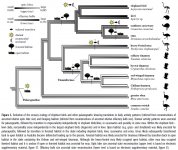Fred Ruhe
Well-known member

Phoebe L. McInerney, Michael S. Y. Lee, Alice M. Clement and Trevor H. Worthy, 2019
The phylogenetic significance of the morphology of the syrinx, hyoid and larynx, of the southern cassowary, Casuarius casuarius (Aves, Palaeognathae
BMC Evolutionary Biology 19, Article number: 233
doi: https://doi.org/10.1186/s12862-019-1544-7
https://bmcevolbiol.biomedcentral.com/articles/10.1186/s12862-019-1544-7
Free pdf:
https://bmcevolbiol.biomedcentral.com/track/pdf/10.1186/s12862-019-1544-7
Abstract
Background: Palaeognathae is a basal clade within Aves and include the large and flightless ratites and the smaller, volant tinamous. Although much research has been conducted on various aspects of palaeognath morphology, ecology, and evolutionary history, there are still areas which require investigation. This study aimed to fill gaps in our knowledge of the Southern Cassowary, Casuarius casuarius, for which information on the skeletal systems of the syrinx, hyoid and larynx is lacking - despite these structures having been recognised as performing key functional roles associated with vocalisation, respiration and feeding. Previous research into the syrinx and hyoid have also indicated these structures to be valuable for determining evolutionary relationships among neognath taxa, and thus suggest they would also be informative for palaeognath phylogenetic analyses, which still exhibits strong conflict between morphological and molecular trees.
Results: The morphology of the syrinx, hyoid and larynx of C. casuarius is described from CT scans. The syrinx is of the simple tracheo-bronchial syrinx type, lacking specialised elements such as the pessulus; the hyoid is relatively short with longer ceratobranchials compared to epibranchials; and the larynx is comprised of entirely cartilaginous, standard avian anatomical elements including a concave, basin-like cricoid and fused cricoid wings. As in the larynx, both the syrinx and hyoid lack ossification and all three structures were most similar to Dromaius. We documented substantial variation across palaeognaths in the skeletal character states of the syrinx, hyoid, and larynx, using both the literature and novel observations (e.g. of C. casuarius). Notably, new synapomorphies linking Dinornithiformes and Tinamidae are identified, consistent with the molecular evidence for this clade. These shared morphological character traits include the ossification of the cricoid and arytenoid cartilages, and an additional cranial character, the articulation between the maxillary process of the nasal and the maxilla.
Conclusion: Syrinx, hyoid and larynx characters of palaeognaths display greater concordance with molecular trees than do other morphological traits. These structures might therefore be less prone to homoplasy related to flightlessness and gigantism, compared to typical morphological traits emphasised in previous phylogenetic studies.
Enjoy,
Fred
The phylogenetic significance of the morphology of the syrinx, hyoid and larynx, of the southern cassowary, Casuarius casuarius (Aves, Palaeognathae
BMC Evolutionary Biology 19, Article number: 233
doi: https://doi.org/10.1186/s12862-019-1544-7
https://bmcevolbiol.biomedcentral.com/articles/10.1186/s12862-019-1544-7
Free pdf:
https://bmcevolbiol.biomedcentral.com/track/pdf/10.1186/s12862-019-1544-7
Abstract
Background: Palaeognathae is a basal clade within Aves and include the large and flightless ratites and the smaller, volant tinamous. Although much research has been conducted on various aspects of palaeognath morphology, ecology, and evolutionary history, there are still areas which require investigation. This study aimed to fill gaps in our knowledge of the Southern Cassowary, Casuarius casuarius, for which information on the skeletal systems of the syrinx, hyoid and larynx is lacking - despite these structures having been recognised as performing key functional roles associated with vocalisation, respiration and feeding. Previous research into the syrinx and hyoid have also indicated these structures to be valuable for determining evolutionary relationships among neognath taxa, and thus suggest they would also be informative for palaeognath phylogenetic analyses, which still exhibits strong conflict between morphological and molecular trees.
Results: The morphology of the syrinx, hyoid and larynx of C. casuarius is described from CT scans. The syrinx is of the simple tracheo-bronchial syrinx type, lacking specialised elements such as the pessulus; the hyoid is relatively short with longer ceratobranchials compared to epibranchials; and the larynx is comprised of entirely cartilaginous, standard avian anatomical elements including a concave, basin-like cricoid and fused cricoid wings. As in the larynx, both the syrinx and hyoid lack ossification and all three structures were most similar to Dromaius. We documented substantial variation across palaeognaths in the skeletal character states of the syrinx, hyoid, and larynx, using both the literature and novel observations (e.g. of C. casuarius). Notably, new synapomorphies linking Dinornithiformes and Tinamidae are identified, consistent with the molecular evidence for this clade. These shared morphological character traits include the ossification of the cricoid and arytenoid cartilages, and an additional cranial character, the articulation between the maxillary process of the nasal and the maxilla.
Conclusion: Syrinx, hyoid and larynx characters of palaeognaths display greater concordance with molecular trees than do other morphological traits. These structures might therefore be less prone to homoplasy related to flightlessness and gigantism, compared to typical morphological traits emphasised in previous phylogenetic studies.
Enjoy,
Fred





